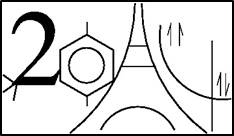With the aim of designing new inorganic photosensitizers for photovoltaic applications, the structural and electronic properties of two Ru(II) complexes containing terpyridine-based ligands derived from expanded pyridinium - both branched-polyphenyl-and fused-polycyclic - were investigated by the means of Density Functional Theory (DFT) and Time-dependent DFT(TDDFT). In particular, the structure and electronic absorption of the fused architectures - including the isolated ligand and its complex - were compared to those of their respective branched precursors with the aim to account for the their enhhanced electronic features in the visible spectral region. The theoretical insights gained from the “large-surface” ligand and its associated complex open the route for a joint experimental and theoritical design of new inorganic photosensitizers based on fused expanded pyridiniums.
|
|
|
|
Ruthenium (II) complexes with new large-surface ligands based on electron-accepting expanded pyridiniums: insights from Density Functional Theory
1 : 1 LECIME, Laboratoire d'Electrochimie, Chimie des Interfaces et Modélisation pour l'Energie, UMR 7575 CNRS, 2 Laboratoire de chimie de matériaux et des vivants : Activité, Réactivité, Université de Batna 05000, Algerie 1-Ecole Nationale Supérieure de Chimie de Paris – Chimie Paris Tech, 11 rue P. et M. Curie, 75231 Paris Cedex 05, France. 2- Université de Batna 05000, Algerie. -
Algérie
|
| Personnes connectées : 1 | Flux RSS |

|

 PDF version
PDF version